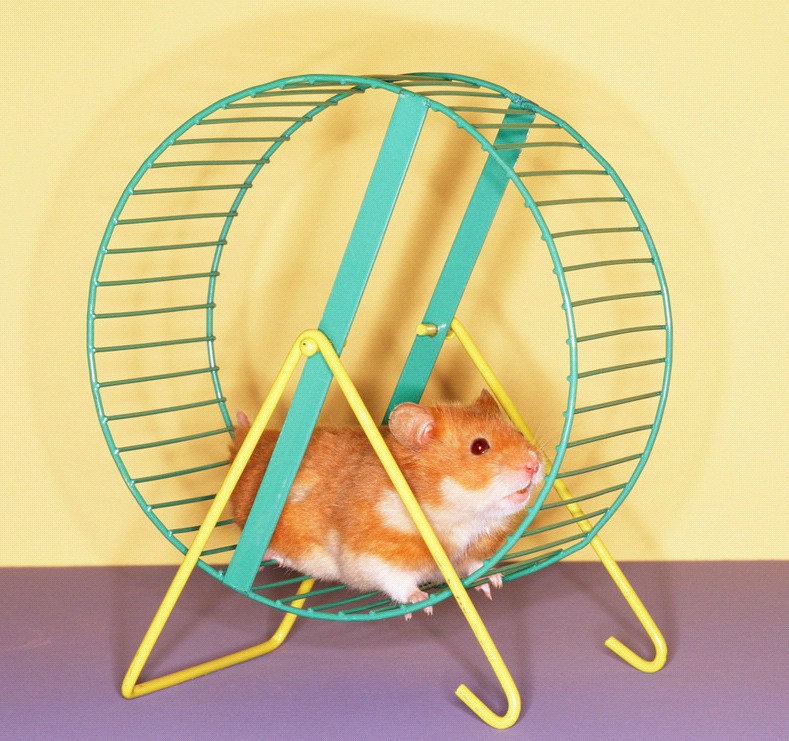10 Tips To Raise Hamsters
Hamsters have always impressed me as good pets; these small, fury and seemingly harmless creatures require a lot of attention.
10 valuable tips to raise hamsters:
1) Pick the right cage: The size of the cage would depend on the hamster you adopt; while Syrian hamsters love to live in isolation and require a smaller cage than dwarf hamsters that are social and enjoy company. The cage should have plenty of space to eat, sleep and exercise. Keep their cage away from direct sunlight and line it with shavings, hay, shredded paper or pellets.
2) Give them nutritious food to eat: Hamsters collect foods in their cheeks and eat it periodically. They have high metabolism and an instinctive desire to hoard food in their cages. They should be fed small portions of seeds and pellets during the same time every day. In addition to treats they can be fed vegetables like spinach, broccoli and cauliflower in moderation.
3) Ensure they exercise well: Hamsters have a lot of energy to expel, so it is essential to make sure to provide them with an exercise wheel or ball or climbing tubes to play, climb and run around.

4) Provide them with fresh water every day: Fresh water is vital for hamsters or they could die of dehydration without water for a day or two. Make sure you fill the water bottles daily with fresh water; in case you use bowls, make sure you clean and refill it with water every day.
5) Ensure you clean the cage every day: The cage of a hamster should be cleaned daily off soiled bedding, droppings and uneaten food that has turned stale. The food and water bowls/bottles should be cleaned every day and the cage should be completely scrubbed with warm soapy water once a week.
6) Put the lights off at night: Hamsters are active at night and sleep during the day, so they need 12 hours of light and 12 hours of darkness. They require complete darkness to understand it is time to get up and do things to function like exercise and eating.
7) Build a play pen: Provide ample opportunities for the hamster to exert his energy playing, climbing around and exploring. Get a cage with tubes and plastic to climb around. It would be great to use cardboard to create a maze or move things around to create an entirely new play area.

8) Keep your hamster’s teeth and claws short: Since the hamster’s teeth keep growing throughout life, it is necessary to provide them objects like woodblocks and pine cones to gnaw on to keep the teeth filed and avoid them puncturing a hole into their cheeks and jaws. The same thing applies to their claws; make sure their claws are filed down by placing some sandpaper into their hamster wheel.
9) Watch out for signs of illness: Ensure that your hamster has regular annual check-ups in addition to looking around for signs of illness like dull-looking eyes, overgrown teeth, matted fur, shaking, pneumonia and diarrhea. Consult your vet immediately in such cases.
10) Choose a good vet that examines and treats small animals: This can be easily done by having a look at Association of Exotic Mammal Veterinarian website. After the choice call ahead and speak with the veterinarian to ensure they have ample experience with hamsters.
Image Courtesy: Google
Take the next step toward your goals
Share your requirement and find the best care providers in your area
-
Looking for a caretaker’s job? Build your profile and get in touch with families in your vicinity.
-
Discover nannies, babysitters, cooks, housekeepers, pet sitters, and elder care under one roof.
-
Get all the support you need to run a successful care center.
-
Search for appropriate centers near you depending on your needs.
Care Corner Insights: Blog Library

A Parent’s Guide to Understanding Summer Camp Programs
Because picking the right camp is almost as hard as getting your kid to pack on time! What Exactly Is a Summer Camp Program? At its heart, a summer camp

Deep Cleaning or Daily Help? Best Housekeepers in Orlando, FL
Orlando's magic isn't just found in its theme parks – it's also in coming home to a spotless, welcoming space after a long day. Whether you're a busy professional juggling work commitments, a family managing school schedules and activities, or someon

Daycare or Nanny? Pros and Cons Every Parent Should Consider in Milpitas, CA
Parenting is filled with tough decisions, and one of the biggest ones comes early: Should you choose a daycare or hire a nanny? For families in Milpitas, CA

Should Your Child Learn a Language, an Instrument, or a Sport? Here's How to Decide in Newark, CA
In a city like Newark, CA, where opportunities meet diversity, parents often find themselves wondering: Should I enroll my child in a language class, a music lesson

The Power of Practice: Lessons from Sports, Music, & Academics in Sacramento, CA
Whether it's sinking the perfect basketball shot In the heart of Sacramento, we see this rule play out every single day. From school kids rehearsing their spelling bees to budding pianists and future basketball stars, consistent practice isn't just a

Cooking for Special Diets? How a Personal Cook Can Make Life Easier in Frisco, TX
From gluten-free and keto to Jain, vegan, or sugar-free—dietary needs aren’t just a trend, they’re a lifestyle. And in a fast-moving place like Frisco, TX, keeping up with those special meal requirements can feel like juggling hot pans with one hand

Tutoring for All Talents: Finding the Right Class for Your Child in Irving, TX
Every child is a world of potential waiting to shine — and as parents, one of the best gifts we can give them is the right environment to explore, learn, and thrive. Whether your little one is a budding artist, a math whiz, a future scientist, or a p

More than Just Fun: Why Dance, Music, & Sports Make the Best Summer Activities in Boston, MA
When summer rolls into Boston, it's not just the weather that heats up—it’s the energy, excitement, and endless opportunities for kids and teens to explore, grow, and shine. Parents, if you're wondering how to make the most of your child’s summer vac

Why Summer Camp Is the Best Investment in Your Child's Growth
Summer’s here, and with it comes the question every parent asks: How do I keep my child engaged, happy, and learning while school’s out? The answer? Summer camp! It’s not just a place to keep kids busy—it’s a full-blown investment in their future, de

From Arts to Athletics: Top Activities Offered at Summer Camps
Summer camps are more than just a way to keep kids busy—they’re where friendships blossom, creativity soars, and new passions are born. Whether your child loves painting or prefers the thrill of a soccer match, today’s summer camps offer a little som